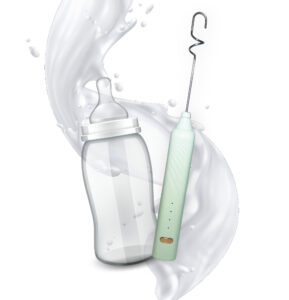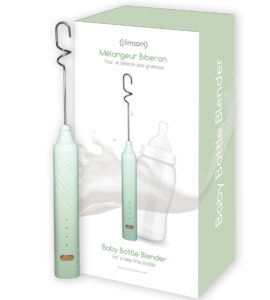
Thickened milk: how to avoid lumps in the bottle?
Whether you’re using a milk thickener (such as starch or carob) or a pre-thickened infant formula, you’re likely facing the same issue as many parents: stubborn lumps!
You’ve tried various techniques to avoid lumps:
- follow the instructions on your thickened milk to the letter,
- add the milk slowly to avoid air bubbles,
- stir the milk with a fork,
- use a feeding bottle with a special thickened milk teat,
- clean the bottle and teat after each use to avoid any residue,
- use lukewarm water…
You’ve tried everything but nothing works! There are always lumps in the milk.
So, how can you prevent lumps in thickened milk?
How do you mix thickened milk?
Thickened milk is already more challenging for a baby to suck than regular milk, but if lumps get in the way, it becomes a real problem! And that’s a problem that’s repeated at every meal. And there are a lot of meals at this age!
Imagine being able to prepare a bottle of lump-free thickened milk powder in no time. A bottle that your baby could drink at his own pace, without any untimely lumpy interruptions. No lumps to be found, just fluid, homogeneous milk swallowed calmly and without stress…

Indeed, the struggle with fussy babies can quickly become a thing of the past, thanks to a crucial bottle accessory. At 5 to 6 feeds a day, believe me, it’s going to make your life a whole lot easier!
It’s not only efficient… it’s also quick (we know how impatient our baby can be when it’s feeding time!). It takes less than a minute to prepare the perfect bottle!
The baby bottle mixer features an anti-clog whisk. And this electric milk mixer is going to revolutionise bottle-feeding time!
20 seconds: it’s the time it takes to get rid of the lumps that usually plague bottles of thickened milk.
But be careful not to choose just any model of electric anti-gruff mixer!

How do I choose the right anti-lumps mixer?
This is a crucial question, because not all bottle mixers are created equal…
- Some are really noisy!
- Others do not comply with safety standards or become unusable after 1 month.
- Some bottle blenders become unusable as soon as they are used for the first time, as the stem quickly falls into the bottle during operation…
- Others operate at speeds that are far too fast, causing splashes…
We take a look at the essential criteria!
1. Speeds adapted to avoid splashes
This solution is supposed to make your life easier, not more complicated. If every time you prepare a bottle you have to end up with a cleaning session because of all the splashing, forget it!
You’ll need to pay close attention to the minimum speed offered by the bottle shaker. This is calculated in rpm (revolutions per minute) and we advise you to aim for less than 3,500 rpm to considerably reduce the risk of splashing.
Also, milk frothers are not suitable for mixing a feeding bottle! And take a good look at the shape of the stem and ask yourself whether such a shape will be able to cope with lumps…
2. Quick and easy to clean
Given the number of feeding bottles you prepare every day, it’s vital to save time when it comes to cleaning. So it’s best to choose a bottle mixer whose design won’t make cleaning a nightmare. Out with the top, in with the whisk. But be careful with the shape of the whisk: thickened milk doesn’t come in all shapes!
3. Long autonomy
Do you want to change the batteries every week?
The economical and practical solution is to look into battery-powered bottle mixers. With their long autonomy, you’ll never run out of batteries when you need them most! An important criterion for your nerves!
4. Safety first and foremost
As the material of the whisk is in direct contact with the milk, care must be taken with the materials used. Obviously, they must not start to rust after being washed several times. There’s also a risk that an inexpensive bottle mixer will fail you after just a few uses… Sometimes it’s better to add a few euros so you don’t have to buy it again! Some blenders can be reused for the next baby or to save time in the kitchen (omelettes, hot chocolate, protein drinks, etc.).
No time to look?
We have a model that meets all the criteria:
- 3 speeds, including 1 very slow speed (3300 rpm – rotations per minute) to avoid splashing while blending properly.
- quick and easy to clean: simply run the spindle under water straight after use.
- rechargeable via USB cable (included) to avoid having to change the batteries after 2 days’ use…
- no batteries but a long-life rechargeable battery. 1 battery charge = 5 to 6 hours’ use, given that mixing the bottle takes 10 to 30 seconds. So you’ll have several hundred bottles in front of you before you need to recharge. In fact, you’ll know when it’s time by the slight drop in intensity of your blender.
- It stands upright on its base, so it doesn’t take up any space when you’re on the move.
- and of course, CE certification and a 304 stainless steel shaft, a healthy, high-quality steel.

Why use thickened milk or AR milk?
Thicker than breast milk or conventional infant milk, thickened milk is often recommended for babies suffering from reflux (GOR) or regurgitation. AR milk is also known as “anti-reflux milk” or “anti-regurgitation milk”. Its thicker consistency can help to keep the milk in the baby’s stomach and reduce the risk of reflux and regurgitation. But this consistency can also encourage lumps: using a bottle mixer may therefore be the solution for dissolving lumps in the thickened milk so that the bottle of thickened milk maintains a fluid flow.
What is the difference between reflux (GOR) and regurgitation?
Although these 2 terms are often used to mean the same thing, they have slightly different meanings.
Regurgitation is a normal, physiological phenomenon that occurs in most infants. It occurs when the contents of the stomach rise up into the oesophagus. Regurgitation is generally benign and does not cause baby any pain.
Gastro-oesophageal reflux disease (GOR), on the other hand, is a digestive disorder that can appear in the 1st year. It occurs when the muscle that normally closes the opening between the oesophagus and the stomach (called the lower oesophageal sphincter) doesn’t work properly. What are the symptoms of GOR? Vomiting a large amount of milk after each meal, showing signs of pain or discomfort after eating, frequent irritability (e.g. crying for no apparent reason) or noisy breathing after meals.





